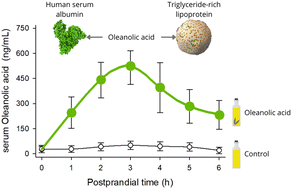Food Funct., 2023, Advance Article
DOI: 10.1039/D3FO02725B, Paper
DOI: 10.1039/D3FO02725B, Paper
 Open Access
Open Access This article is licensed under a Creative Commons Attribution-NonCommercial 3.0 Unported Licence.
This article is licensed under a Creative Commons Attribution-NonCommercial 3.0 Unported Licence.Aída García-González, Juan Manuel Espinosa-Cabello, Isabel Cerrillo, Emilio Montero-Romero, Juan José Rivas-Melo, Andrea Romero-Báez, María Dolores Jiménez-Andreu, Carmen Amelia Ruíz-Trillo, Ana Rodríguez-Rodríguez, Antonio Jesús Martínez-Ortega, María Del Carmen Roque-Cuellar, Silvia García-Rey, Andrés Jiménez-Sánchez, Miguel Ángel Mangas-Cruz, José Luis Pereira-Cunill, Javier S. Perona, Pedro Pablo García-Luna, José María Castellano
A high bioavailability formulation for oleanolic acid (OA) suggests its potential therapeutic application in humans.
To cite this article before page numbers are assigned, use the DOI form of citation above.
The content of this RSS Feed (c) The Royal Society of Chemistry
A high bioavailability formulation for oleanolic acid (OA) suggests its potential therapeutic application in humans.
To cite this article before page numbers are assigned, use the DOI form of citation above.
The content of this RSS Feed (c) The Royal Society of Chemistry

